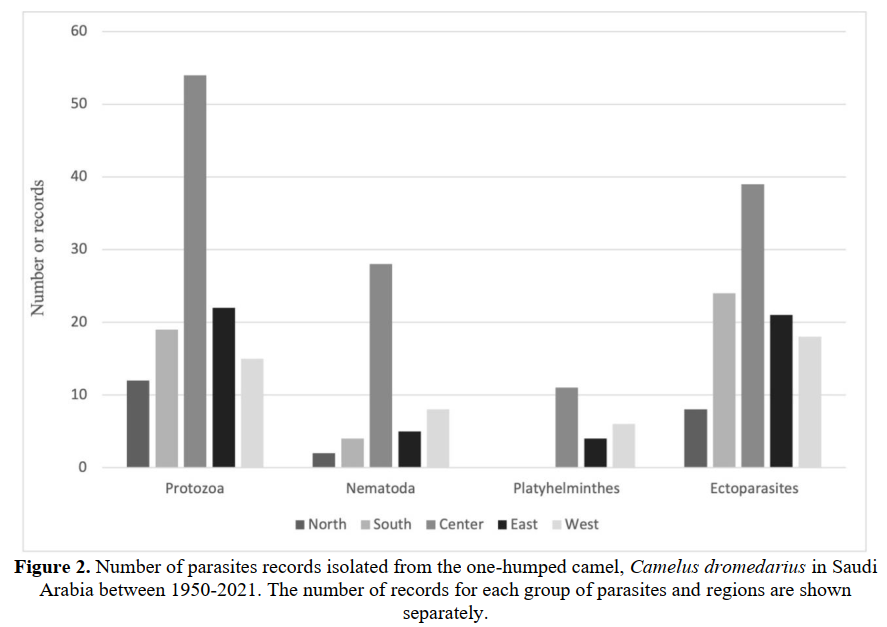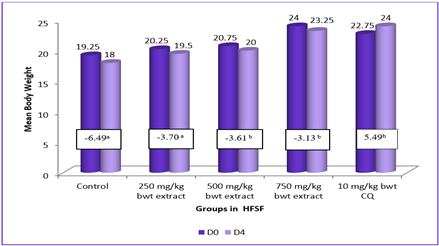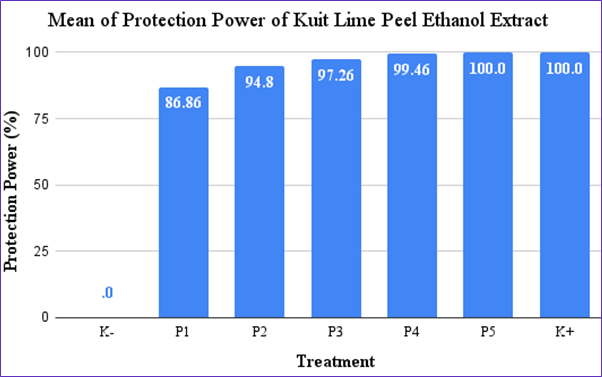The first annotated checklist of parasites infecting the one-humped camel, Camelus dromedarius (Artiodactyla: Camelidae), of Saudi Arabia between 1950-2021

Downloads
Based on the published works of camels in Saudi Arabia, this study is the first checklist of parasites infecting the one-humped camel, Camelusdromedarius in Saudi Arabia between 1950-2021. The present checklist was organized taxonomically in which consist of 75 names representing 4 groups of parasites. The first group is Protozoa with 24 names. Secondly, 13 names of nematodes were reported while there were 12 names of Platyhelminthes. The last group belongs to the Arthropoda which consists of 26 reported species, most of which belong to Ixodida. Based on the resulting checklist, the geographical sampling of these records focuses mainly on the Central, Western, Eastern, and Southern regions, respectively. To date, a few studies have recorded parasites in the North region. The evidence reviewed in this list seems to suggest that further research should be undertaken to investigate the biodiversity of parasites infecting camels from the northern region of Saudi Arabia, which is connected to other continents of Asia, Africa, and Europe.
Abd Alfatah, M.E. (2021) ‘Prevalence of gastrointestinal parasitic infestations with hematobiochemical disorders in dromedary camel’. Egyptian Academic Journal of Biological Sciences, E. Medical Entomology & Parasitology, 13(2), pp. 1-9. Available at: https://doi.org/10.21608/eajbse.2021.206524
Abdally, M.H. (2008a) ‘Identification of Hard Tick Species Affecting Camels (Camelus Dromedarius) and Their Seasonal Abundance in Najran, Saudi Arabia’. Alexandria Science Exchange Journal, pp. 71-76.
Abdally, M.H. (2008b) ‘Species of ticks on camels and their monthly population dynamics in Arar city, KSA’. Assiut Veterinary Medical Journal, 54(117), pp. 302-309.
Abdally, M.H. (2008c) ‘A Survey of Animal Myiasis Among Cases Attending The Veterinary Teaching Hospital of King Faisal University, Al-Ahsa, Saudi Arabia’. Assiut Veterinary Medical Journal, 54(118), pp. 1-9. Available at:https://doi.org/10.21608/AVMJ.2008.175945
Abdally, M.H., et al. (2020) ‘Incidence and Prevalence of Hard Ticks in Ruminants of Al-Ahsa Oasis Region, Kingdom of Saudi Arabia. World’s Veterinary Journal, 10(3): 276-285. https://doi.org/10.36380/scil.2020.wvj36
Al-Afaleq, A.I. et al. (2015) ‘Epidemiological aspects of camel trypanosomosis in Saudi Arabia’. Journal of Camel Practice and Research, 22(2), pp. 231-234. Available at: https://doi.org/10.5958/2277-8934.2015.00037.5
Al-Anazi, A.D. (2011) ‘Prevalence of Neospora caninum and Toxoplasma gondii antibodies in sera from camels (Camelus dromedarius) in Riyadh Province, Saudi Arabia’. Journal of the Egyptian Society of Parasitology, 41(2), pp. 245-250.
Al-Hizab, F.A. et al. (2021) ‘Three species of Echinococcus granulosus sensu lato infect camels on the Arabian Peninsula’. Parasitology Research, 120(6), pp. 2077-2086. Available at: https://doi.org/10.1007/s00436-021-07156-1
Al-Khalifa, M. et al. (1987) ‘Ticks (Acari: Ixodidae) infesting local domestic animals in western and southern Saudi Arabia’. Arab Gulf Journal of Scientific Research, 5, pp. 301-319.
Al-Khalifa, M. et al. (2009) ‘Blood parasites of livestock in certain regions in Saudi Arabia’. Saudi Journal of Biological Sciences, 16(2), pp. 63-67. Available at: https://doi.org/10.1016/j.sjbs.2009.10.002
Al-Khatib, R. (2011) ‘Serological studies of Toxoplasma gondii infection in camels (Camelus dromedarius)’. Assiut Veterinary Medical Journal, 57(130), pp. 1-10. Available at : https://doi.org/10.21608/AVMJ.2011.176865
Al-Megrin, W.A. (2015a) ‘Comparison of ELISA and microscopy for detection of Cryptosporidium oocysts in animals’. Pakistan Journal of Biological Sciences, 18(7), pp. 341-345. Available at: https://doi.org/10.3923/pjbs.2015.341.345
Al-Megrin, W.A. (2015b) ‘Prevalence rate of intestinal parasites in camels in Riyadh, Saudi Arabia’. International Journal of Zoological Research, 11(2), pp. 65. Available at: https://doi.org/10.3923/ijzr.2015.65.70
Al-Megrin, W.A. (2020) ‘Camels: A Source of Transmitting Parasites’. Asian Journal of Emerging Research, 2(4), pp. 168-169.
Al-Mutairi, N., Taha, H., and Nigm, A. (2020) ‘Molecular characterization of Echinococcus granulosus in livestock of Al-Madinah (Saudi Arabia)’. Journal of Helminthology, 94. Available at: https://doi.org/10.1017/S0022149X20000395
Al-Qarawi, A. et al. (2004) ‘Trypanosomiasis-induced infertility in dromedary (Camelus dromedarius) bulls: changes in plasma steroids concentration and semen characteristics’. Animal reproduction science, 84(1-2), pp. 73-82. Available at: https://doi.org/10.1016/j.anireprosci.2003.10.013
Al-Salameen, M. et al. (2016) ‘The effect of camel (Camels dromedarius) sex and age on susceptibility to blood parasites infection in AL-Ahsa province of Saudi Arabia’. Journal of Veterinary Science & Animal Husbandry, 4(3), pp. 306.
Al-Shammery, K.A., Fetoh, B., and Alshammari, A.M. (2011) ‘Differentiation between common tick species using molecular biology techniques in Saudi Arabia’. International Journal of Biological, Veterinary, Agricultural and Food Engineering, 5(1), pp. 305-307.
Al-Swailem, A. M., et al. (2007) ‘Classification of Saudi Arabian camel (Camelus dromedarius) subtypes based on RAPD technique’. Journal of Food Agriculture and Environment, 5(1), pp. 143.
Al-Tayib, O. (2014) ‘Case report zoonotic balantidiasis in camel from Saudi Arabia’. Scholar Academic Scientific Publisher, 2(7)’ pp. 445-447.
Alahmed, A. (2002) ‘Seasonal Prevalence of Cephalopina titillator Larvae in Camels in Riyadh Region, Saudi’. Arab Gulf Journal of Scientific Research, 20(3), pp. 161-164.
Alajmi, R. et al. (2019) ‘Molecular identification of ticks infesting camels and the detection of their natural infections with Rickettsia and Borrelia in Riyadh province, Saudi Arabia’. Tropical Biomedicine, 36(3), pp. 758-765.
Alanazi, A.D (2013) ‘Determination of seropositivity for Toxoplasma gondii in sheep, goats and camels slaughtered for food and human consumptions in Riyadh municipal abattoirs, Saudi Arabia’. Journal of the Egyptian Society of Parasitology, 43(3), pp. 569-576. Available at: https://doi.org/10.12816/0006414
Alanazi, A. et al. (2018a) ‘Tick-borne pathogens in ticks and blood samples collected from camels in Riyadh province, Saudi Arabia’. International Journal of Zoological Research, 14(1), pp. 30-36. Available at: https://doi.org/10.3923/ijzr.2018.30.36
Alanazi, A. et al. (2018b) ‘Ticks (Acari: Ixodidae) infesting domestic and wild mammalians on the Riyadh province, Saudi Arabia’. Journal of Entomology, 15(2), pp. 75-82. Available at: https://doi.org/10.3923/je.2018.75.82.
Alanazi, A. et al. (2018c) ‘Molecular epidemiological studies on Trypanosoma evansi type a and type b in camels (Camelus dromedaries) from five different regions of Saudi Arabia using the its1 rDNA and rotat 1.2 vsg gene’. Journal of the Egyptian Society of Parasitology, 48(2). Pp. 241-250. Available at: https://doi.org/10.12816/0050431
Alanazi, A. D. et al. (2019) ‘Species diversity and seasonal distribution of hard ticks (Acari: Ixodidae) infesting mammalian hosts in various districts of Riyadh Province, Saudi Arabia’. Journal of Medical Entomology, 56(4), pp. 1027-1032. Available at: https://doi.org/10.1093/jme/tjz036
Alanazi, A.D. et al. (2020) ‘Ticks and associated pathogens in camels (Camelus dromedarius) from Riyadh Province, Saudi Arabia’. Parasites & Vectors, 13(1), pp. 1-9. Available at: https://doi.org/10.1186/s13071-020-3973-y
Mohamed, A.M.E. et al. (2019) ‘Molecular detection of Trypanosoma evansi in camels (Camelus dromedarius) in southwestern Saudi Arabia’. The Thai Journal of Veterinary Medicine, 49(1), pp. 93-100.
Albogami, B. (2020). Genetic diversity among different samples of camel’s tick (Hyalomma dromedarii) in Taif city, Saudi Arabia. Advances in Animal and Veterinary Sciences, 8(3): 285-289. https://doi.org/10.17582/journal.aavs/2020/8.3.285.289
Alhendi, A. (2000). Common diseases of camels (Camelus dromedari) in eastern province of Saudi Arabia. Pakistan Veterinary Journal, 20: 97-99.
Ali, A., Mohamed, K., and Toulah, F. (2017) ‘Prevalence of Toxoplasma gondii in women population of Rafha city, Saudi Arabia’. Pakistan Journal of Zoology, 49(3), pp. 1039-1047.
Aljumaah, R.S. et al. (2018) ‘Serological Prevalence of Neospora caninum in Indigenous Dromedary Camels (Camelus dromedarius) in Saudi Arabia’. Pakistan Journal of Zoology, 50(4), pp. 1199-1203. Available at: https://doi.org/10.17582/journal.pjz/2018.50.4.1199.1203
Bakhraibah, A.O., and Alsulami, M.N. (2018) ‘Prevalence of Cysticercus ovis among slaughtered goats in Makkah, Saudi Arabia’. Biosciences Biotechnology Research Asia, 15(4), pp. 909-914. Available at: https://doi.org/10.13005/bbra/2701
Bakhraibah, A.O. et al. (2018) ‘Experiment of Hydatid Cyst in Two Strains (Camels and Goats) in Saudi Arabia’. Open Journal of Animal Sciences, 9(1), pp. 76-87. Available at: https://doi.org/10.4236/ojas.2019.91007
Boid, R., Jones, T., and Luckins, A. (1985) ‘3. Protozoal diseases of camels’. British Veterinary Journal, 141(1), pp. 87-105.
Charrel, R.N. et al. (2007). ‘Fever Virus in Ornithodoros savignyi Ticks’. Emerging Infectious Diseases, 13(1), pp. 153-155. Available at: https://doi.org/10.3201/eid1301.061094
Cheema, A. et al. (1984) ‘Onchocerciasis in camels (Camelus dromedarius) in Saudi Arabia’. Journal of Helminthology, 58(4), pp. 279-285. Available at: https://doi.org/10.1017/S0022149X0002513X
Dajem, S. et al. (2019) ‘Taxonomic justification of the pathogenic strongylid infecting the Arabian camel Camelus dromedarius as Haemonchus longistipes by morphological and molecular phylogeny’. Journal of Veterinary Research, 63(1), pp. 51-61. Available at: https://doi.org/10.2478/jvetres-2019-0019
Diab, F.M. et al. (2006) ‘Ticks (Acari: Argasidae, Ixodidae) infesting livestock in Saudi Arabia’. Fauna of Arabia, 22, pp. 233-242. Available at: https://doi.org/10.3923/je.2018.75.82
El Shoura, S.M. et al. (1990) ‘Detection of Escherichia coli in the naturally infected female cameltick Hyalomma (Hyalomma) dromedarii (Ixodoidea: Ixodidae)’. International Journal of Acarology, 16(2), pp. 63-66. Available at: https://doi.org/10.1080/01647959008683514
El Wathig, M., and Faye, B. (2013) ‘Surveillance of camel trypanosomosis in Al-Jouf región, Saudi Arabia’. Camel: An International Journal of Veterinary Sciences, 1(1), pp. 65.
El Wathig, M., and Faye, B. (2016) ‘Camel calf diarrhoea in Riyadh region, Saudi Arabia’. Journal of Camel Practice and Research, 23(2), pp. 283-285.
El-wathig, M. et al. (2016) ‘Epidemiological surveys of camel trypanosomosis in Al-jouf, Saudi Arabia based on PCR and ELISA’. Emirates Journal of Food and Agriculture, 28(3), pp. 212-216.
El-Bahy, M., Omer, O., and Al-Sadrani, A. (2008) ‘Temperature difference and parasite infection at Qassim region, Saudi Arabia’. Research Journal of Parasitology, 3(4), pp. 114-122.
El-Metenawy, T. (1999) ‘An abattoir survey of metacestodes among the slaughtered ruminants at Al-Qassim Area, Saudi Arabia’. Veterinary Medical Journal Giza, 47(2), pp. 199-204.
Elamin, E. et al. (2001) ‘Prenatal infection with a hydatid cyst in a camel (Camelus dromedarius)’. The Veterinary Record, 149(2), pp. 59-60. Available at: https://doi.org/10.1136/vr.149.2.59
Elbir, H., Almathen, F., and Elnahas, A. (2020) ‘Low genetic diversity among Francisella-like endosymbionts within different genotypes of Hyalomma dromedarii ticks infesting camels in Saudi Arabia’. Veterinary World, 13(7), pp. 1462. Available at: https://doi.org/10.14202/vetworld.2020.1462-1472
Elobaid, N. et al. (2021) ‘Phylogenetic analysis of Trypanosoma evansi isolates in naturally infected camels from Kingdom of Saudi Arabia’. International Journal of Current Microbiology and Applied Sciences, 10(4), pp. 532-543. Available at: https://doi.org/10.20546/ijcmas.2021.1004.052
Fallatah, S., Ghallab, E., and Khater, E. (2019) ‘Phylogenetic diversity and DNA barcoding of the camel tick Hyalomma dromedarii (Acari: Ixodidae) of the Eastern region of Saudi Arabia’. Tropical Biomedicine, 36(2), pp. 390-401.
Fatani, A. et al. (1996) ‘Prevalence of Sarcocystis in camels (Camelus dromedarius) from Al-Ahsa, Saudi Arabia’. Veterinary Parasitology, 62(3-4), pp. 241-245. Available at: https://doi.org/10.1016/0304-4017(95)00843-8
FAOSTAT. (2020) Food and Agriculture Organization of the United Nations Statistics Division. Available at: https://www.fao.org/faostat/en/#home
Fdaladdin, Y.A.J., Alsaggaf, A.I., and Wakid, M.H. (2018) ‘Comparative epidemiological studies on Echinococcosis of local and imported livestock in Al-madina Al-munawwarah in Saudi Arabia’. The Egyptian Journal of Hospital Medicine, 50(1), pp. 108-126. Available at: https://doi.org/10.21608/EJHM.2018.16080
Ghandour, A., Al-Amoudi, A., and Banaja, A. (1991) ‘Onchocerca fasciata Railliet and Henry, 1910 and its nodule development in camels in Saudi Arabia’. Veterinary Parasitology, 39(1-2), pp. 67-77. Available at:https://doi.org/10.1016/03044017(91)90063-2
Haroun, E. et al. (1996) ‘The haematological and biochemical effects of the gastrointestinal nematodes prevalent in camels (Camelus dromedarius) in central Saudi Arabia’. Veterinary Research Communications, 20(3), pp. 255-264. Available at: https://doi.org/10.1007/BF00366923
Hassan, E.M.E. et al. (2011) ‘The Occurrence and Prevalence of Haemonchus longistipes in Dromedaries (Camelus dromedarius) in Al-Ahsa Area, Saudi Arabia’. Scientific Journal of King Faisal University (Basic and Applied Sciences), 12(2), pp. 1432.
Hemida, M.G. et al. (2021) ‘Lack of detection of the Middle East respiratory syndrome coronavirus (MERS-CoV) nucleic acids in some Hyalomma dromedarii infesting some Camelus dromedary naturally infected with MERS-CoV’. BMC Eesearch Notes, 14(1), pp. 1-6. Available at: https://doi.org/10.1186/s13104-021-05496-w
Hilali, M., Fatani, A., and Al-Atiya, S. (1995) ‘Isolation of tissue cysts of Toxoplasma, Isospora, Hammondia and Sarcocystis from camel (Camelus dromedarius) meat in Saudi Arabia’. Veterinary Parasitology, 58(4), pp. 353-356. Available at : https://doi.org/10.1016/0304-4017(94)00727-T
Hoter, A., Rizk, S., and Naim, H. Y. (2019) ‘Cellular and molecular adaptation of Arabian camel to heat stress’. Frontiers in Genetics, 10, pp. 588. Available at : https://doi.org/10.3389/fgene.2019.00588
Hussein, M. et al. (1982) ‘The pathology of nasopharyngeal myiasis in Saudi Arabian camels (Camelus dromedarius)’. Veterinary Parasitology, 9(3-4), pp. 179-183. Available at: https://doi.org/10.1016/0304-4017(82)90060-7
Hussein, M. et al. (1983) ‘Cephalopina titillator (Clark 1797) infection in Saudi Arabian camels’. Zentralblatt für Veterinärmedizin Reihe B, 30(1‐10), pp. 553-558. Available at: https://doi.org/10.1111/j.1439-0450.1983.tb01882.x
Hussein, H. et al. (1991) ‘The blood parasites of indigenous livestock in Saudi Arabia’. Arab Gulf Journal of Scientific Research, 9(3), pp. 143-160.
Hussein, H., Kasim, A., and Shawa, Y. (1987) ‘The prevalence and pathology of Eimeria infections in camels in Saudi Arabia’. Journal of Comparative Pathology, 97(3), pp. 293-297. Available at: https://doi.org/10.1016/0021-9975(87)90093-4
Ismael, A. et al. (2016) ‘First evidence of natural anaplasmosis in Camelus dromedarius in Saudi Arabia’. Journal of Camel Practice and Research, 23(1), pp. 95-100. Available at: https://doi.org/10.5958/2277-8934.2016.00014.X
Issa, H.S. et al. (2018) ‘Molecular Characterization of Echinococcus granulosus sensu stricto Cysts of Domestic Ruminants in Jordan’. Jordan Journal of Biological Sciences, 11(3), pp. 301-306.
Kadim, I.T. et al. (2013) ‘Composition, quality and health aspects of the dromedary (Camelus dromedarius) and bactrian (Camelus bacterianus) camel meats: a review’. Journal of Agricultural and Marine Sciences [JAMS], 18, pp. 7-24.
Kasim, A.A., Hussein, H.S., and Shawa, Y.R.A. (1985) ‘Coccidia in Camels (Camelus dromedarius) in Saudi Arabia 1’. The Journal of Protozoology, 32(1), pp. 202-203. Available at: https://doi.org/10.1111/j.1550-7408.1985.tb03039.x
Metwally, D.M. et al. (2020a) ‘Identification of Sarcocystis spp. in One-humped Camels (Camelus dromedarius) from Riyadh and Dammam, Saudi Arabia, via Histological and Phylogenetic Approaches’. Animals, 10(7), pp. 1-11. Available at: https://doi.org/10.3390/ani10071108
Metwally, D.M. et al. (2020b) ‘Prevalence of eimeriosis in the one-humped camels (Camelus dromedarius) from Riyadh and Al-Qassim, Saudi Arabia’. PeerJ, 8, pp. 1-11. Available at: https://doi.org/10.7717/peerj.10347
Metwally, D.M. et al (2021) ‘Molecular identification of Trypanosoma evansi isolated from arabian camels (Camelus dromedarius) in Riyadh and Al-Qassim, Saudi Arabia’. Animals, 11(4), pp. 1-8. Available at: https://doi.org/10.3390/ani11041149
Ministry of Environment Water and Agriculture. (2021) The Annual Report Book. Saudi Arabia: Ministry of Environment Water and Agriculture.
Mohammed, A. et al. (2017) ‘Lack of evidence for infection of camels with tick-borne diseases in Riyadh region, Saudi Arabia’. Sudan Journal of Veterinary Research, 32, pp. 39-40.
Mohammed, O.B. et al. (2020) ‘Seroprevalence of Toxoplasma gondii and Neospora caninum in Dromedary camels (Camelus dromedarius) from Saudi Arabia’. Revista Brasileira de Parasitologia Veterinária, 29, pp. 1-8. Available at: https://doi.org/10.1590/S1984-29612020008
Moher, D. et al. (2009) ‘Preferred reporting items for systematic reviews and meta-analyses: the PRISMA statement’. Annals of internal medicine, 151(4), pp. 264-269. Available at: https://doi.org/10.7326/0003-4819-151-4-200908180-00135
Mostafa, O., and Saad, D. (2014) ‘Prevalence of Babesia bovis and B. bigemina in animals slaughtered in Abha and Khamis Mushait abattoirs, Aseer, Saudi Arabia, using PCR assay’. Research Journal of Pharmaceutical, Biological and Chemical Sciences, 5(5), pp. 1233-1237.
Nasher, A. (1986) ‘Incidence and intensity of Onchocerca fasciata Railliet and Henry, 1910 in local camels in Saudi Arabia’. Annales de Parasitologie Humaine et Comparée, 61(1), pp. 77-80. Available at: https://doi.org/10.1051/parasite/198661177
Omer, O. et al. (1998). ‘Diagnosis of Trypanosoma evansi in Saudi Arabian Camels (Camelus dromedarius) by the passive haemagglutination test and Ag‐ELISA’. Journal of Veterinary Medicine, Series B, 45(1‐10), pp. 627-633. Available at: https://doi.org/10.1111/j.1439-0450.1998.tb00836.x
Omer, S.A., Alsuwaid, D.F., and Mohammed, O.B. (2021) ‘Molecular characterization of ticks and tick-borne piroplasms from cattle and camel in Hofuf, eastern Saudi Arabia’. Saudi Journal of Biological Sciences, 28(3), pp. 2023-2028. Available at: https://doi.org/10.1016/j.sjbs.2021.01.005
Omer, S.A., Alzuraiq, A.A., and Mohammed, O.B. (2017) ‘Prevalence and molecular detection of Sarcocystis spp. infection in the dromedary camel (Camelus dromedarius) in Riyadh city, Saudi Arabia’. Biomedical Research, 28(11), pp. 4962-4965.
Osama, B.M. et al. (2013) ‘Serosurveillance for some diseases in livestock living within protected areas designated for wildlife reintroduction in Saudi Arabia’. African Journal of Microbiology Research, 7(16), pp. 1574-1578. Available at: https://doi.org/10.5897/AJMR12.2032
The official Saudi Press Agency. (2020) Governor of Qassim region inaugurates largest camel hospital project in the world. Available at: https://www.spa.gov.sa/2391732 .
The EndNote Team. (2013) EndNote. In (Version EndNote 20) [64 bit]. Clarivate.
Toulah, F.H. et al. (2017) ‘Hydatidosis among imported animals in Jeddah, Saudi Arabia’. Journal of Liver and Clinical Research, 4(1), pp. 1031.
Wilson D.E. and Reeder D. M. (eds.). (2005) Mammal Species of the World: A Taxonomic and Geographic Reference. 3rd edn. Baltimore, Maryland, United States: Johns Hopkins University Press
Yam, B.A.Z. (2015) ‘Introduction to Camel origin, history, raising, characteristics, and wool, hair, and skin: a review’. International Journal of Research and Innovations in Earth Science, 2(6), pp. 496-508.
Zakham, F. et al. (2021) ‘Viral RNA Metagenomics of Hyalomma ticks collected from dromedary camels in Makkah Province, Saudi Arabia’. Viruses, 13(7), pp. 1396. Available at: https://doi.org/10.3390/v13071396.
Copyright (c) 2024 Journal of Parasite Science (JoPS)

This work is licensed under a Creative Commons Attribution-NonCommercial-ShareAlike 4.0 International License.
- Every manuscript submitted to must observe the policy and terms set by the Journal of Parasite Science
- Publication rights to manuscript content published by the Journal of Parasite Science is owned by the Journal of Parasite Science with the consent and approval of the author(s) concerned
- Authors and other parties are bound to the Creative Commons Attribution-NonCommercial-ShareAlike 4.0 International License for the published articles, legal formal aspect of journal publication accessibility refers to Creative Commons Attribution-NonCommercial-ShareAlike 4.0 International License (CC BY-NC-SA)
- By submitting the manuscript, the author agrees to the requirement that the copyright of the submitted article will be transferred to Journal of Parasite Science as the publisher of the journal. The intended copyright includes the right to publish articles in various forms (including reprints). journal of parasite science retains the publishing rights to published articles.

































